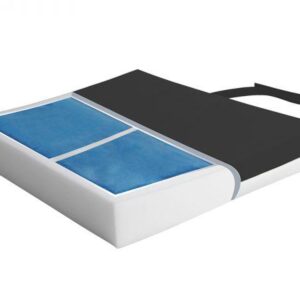Wheelchair Cushions
A high-quality seating cushion is a necessary accessory for any patient who spends most of their day in a wheelchair. Even though the design of wheelchairs has improved significantly over the past years to assure the patient’s comfort and overall wellbeing, an added layer of support and cushioning is critical for preventing irritation, pain, and discomfort.
ReMED offers a wide selection of wheelchair cushions that can suit the needs of any of your patients. So take a look at our offer, and find the right cushions that can help you improve the quality of your care.
Showing 1–12 of 13 results
-

Key
$1.00 -

16″x 16″x 2″- Protekt Foam Cushion
$40.00 -

30”x20”x3″-Protekt-Foam-Cushion
$85.00 -

28”x20”x3″-Protekt-Foam-Cushion
$80.00 -

26”x20”x3″-Protekt-Foam-Cushion
$75.00 -

24″x18″x3″-Protekt-Foam-Cushion
$50.00 -

22″x18″x3″-Protekt-Foam-Cushion
$40.00 -

20″x16″x3″-Protekt-Foam-Cushion
$40.00 -

18″x18″x3″-Protekt-Foam-Cushion
$40.00 -

18″x16″x3″-Protekt-Foam-Cushion
$40.00 -

16″x16″x3″-Protekt-Foam-Cushion
$40.00 -

20″x16″x2″-Protekt-Foam-Cushion
$40.00
The Importance of Finding the Right Wheelchair Cushion
Almost 3 million people in the US alone have permanent mobility issues that require the use of wheelchairs; millions more rely on wheelchairs during their recovery from injuries, surgeries, medical procedures, and more.
While wheelchairs offer higher levels of independence and mobility, they rarely provide these patients with the comfort they need. In addition, spending prolonged periods sitting down can lead to many problems, including poor blood circulation, general discomfort, and pain.
Using a wheelchair without the right cushioning can even lead to the patient developing pressure ulcers that could worsen their condition.
So, it’s evident that wheelchair cushions aren’t just a luxury accessory. They’re an essential component that’ll provide your patients with added support that improves their quality of life.
However, it’s critical to find the right type of cushion. Fortunately, you’ll have a few choices.
Types of Wheelchair Cushions
Some patients will prefer a firmer cushion that’s resilient to wear and tear and has improved durability. Others will require softer cushions that alleviate pressure and allow for better airflow. To meet the needs of these diverse patients, you can choose from a variety of different cushion materials. The most popular options are as follows:
- Latex cushions:
- Resilient, firm, and elastic. They adapt to the patient’s contours to provide maximum comfort. They’re water-resistant and anti-bacterial, but they don’t have sufficient airflow and could heat up rather quickly.
- Gel foam cushions:
- Similar to latex, gel foam cushions contour to the patient’s body. They’re soft and comfortable, designed to almost mimic the protective fatty tissue that prevents bedsores and skin irritation. Their only drawback is the heftier price tag.
- Premium foam cushions:
- Usually regarded as the best option, foam cushions provide stability, skin protection, and comfort. They come in a variety of firmness levels to suit the patient’s needs. Made of breathable materials, they improve the airflow, allowing the patient to stay cool and dry.
Factors to Consider When Selecting a Cushion (patient weight, height…)
When selecting a wheelchair cushion, it’s important to pay attention to several factors that could impact the patient’s wellbeing:
- Posture:
If the patient has muscular atrophy or postural problems while sitting in their wheelchair, they’ll need added support. Wheelchair cushions can be shaped differently to ensure the proper support that promotes better posture. - Mobility levels:
If a patient used their wheelchair 24/7, they’d need soft cushioning that improves their comfort levels. However, firmer cushioning could be a better option
if they can propel themselves or need to move in and out of their chair frequently. - Condition of the skin:
Patients with sensitive skin prone to irritations and bedsores will need high-quality, antibacterial, breathable cushions. - Weight:
All wheelchair cushions will have a weight rating. If the patient is too heavy or too light for a cushion, they won’t receive the proper support. Therefore, make sure that the weight rating of a cushion is suitable for the patient’s weight. - Height:
Your patient needs to be able to place their feet on the wheelchair’s footrest, and a cushion that’s too thick could prevent them from doing so. So always test out the cushion and ensure that your patient can reach the footrest; it’ll improve their safety and stability.
Contact ReMED for More Information About Wheelchair Cushions
ReMED has various wheelchair cushions that can help you improve your quality of care and patient satisfaction. Contact us to learn more about our cushions and other wheelchair accessories.












